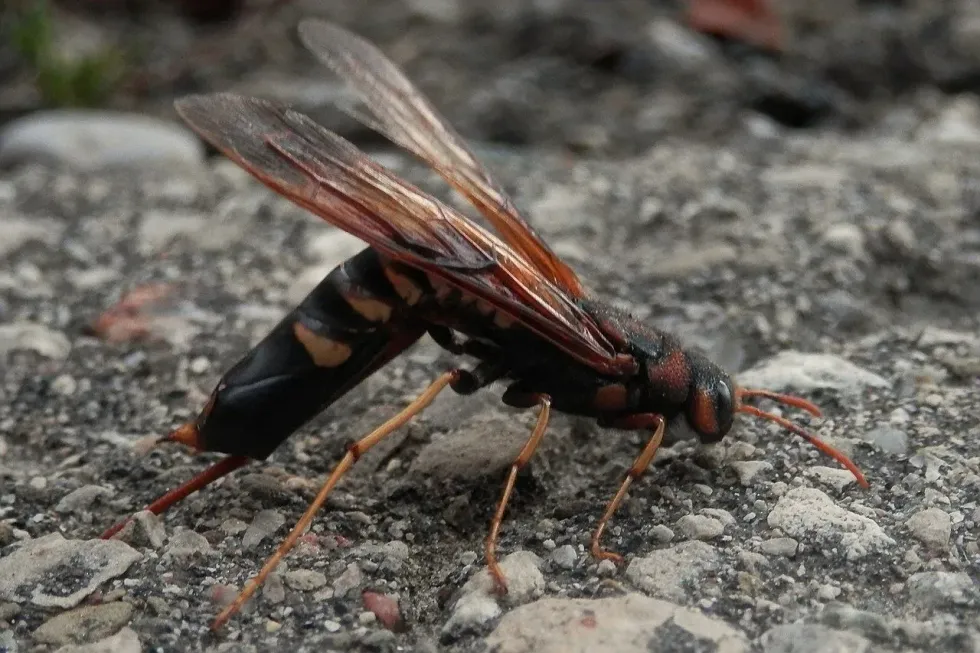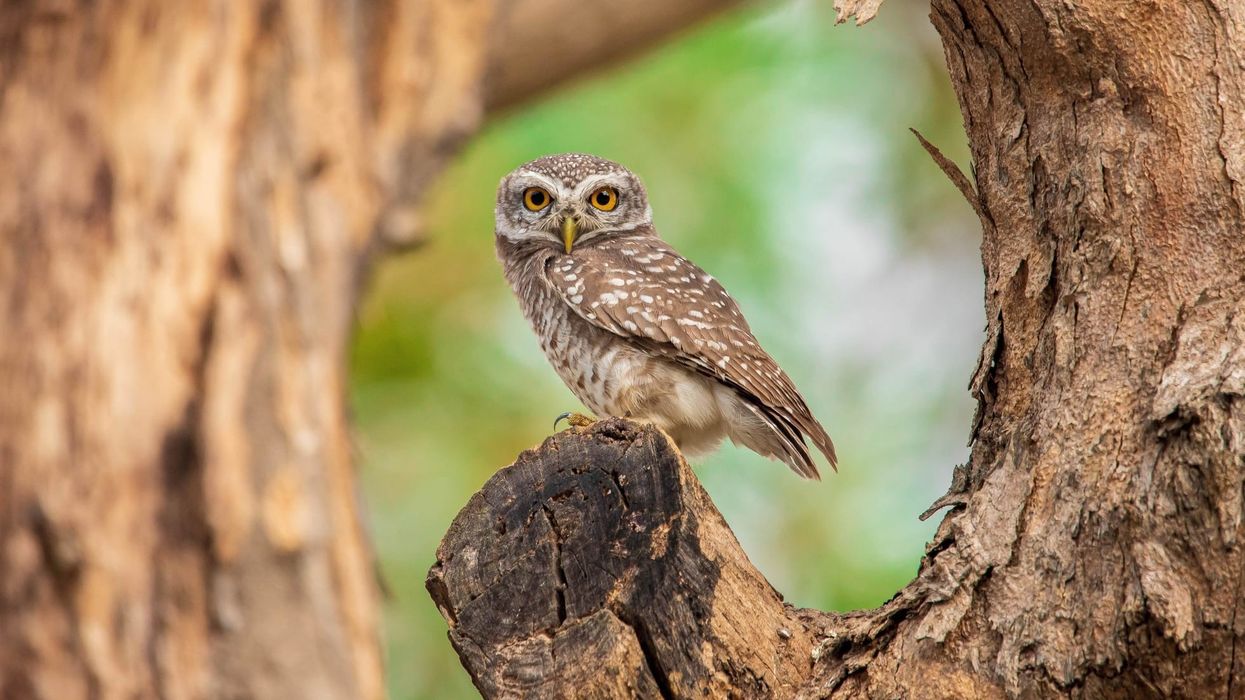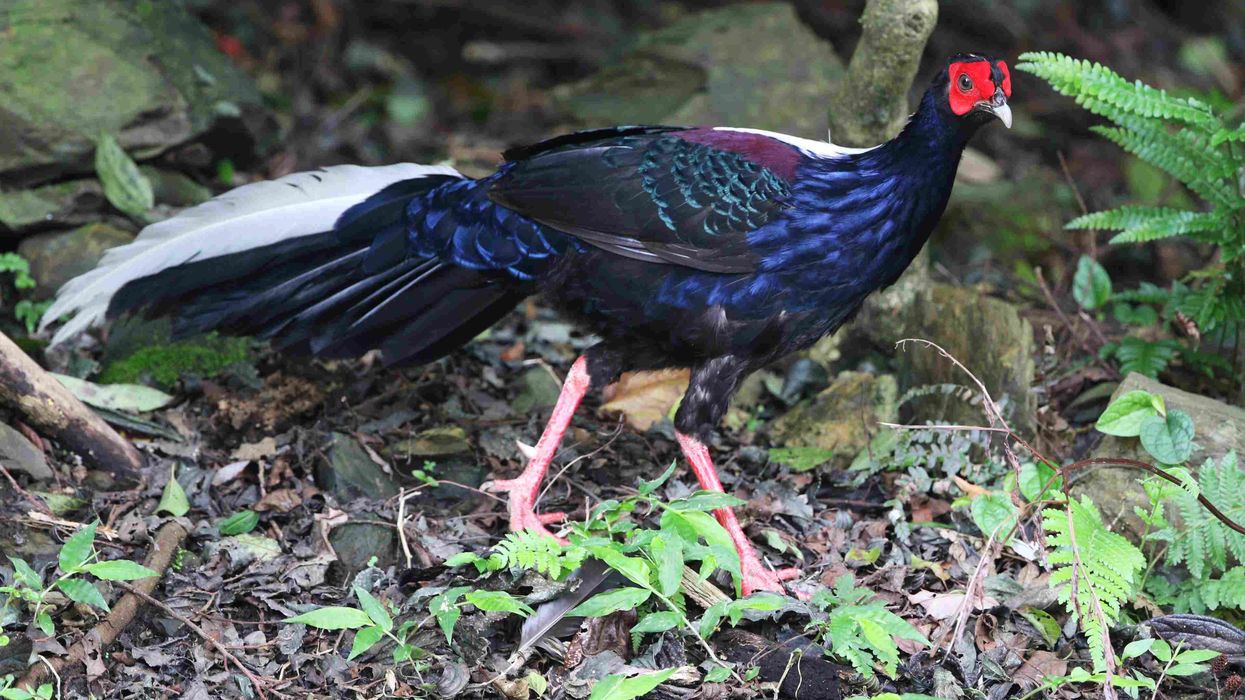The pigeon tremex is one of the most well-known pests around North America (especially Colorado)!
Be careful of this inch-and-a-half long (3.81 cm) insect, but not for the reasons you might think! This wasp is well known all across the Americas for its tendency to not only feed on dead trees and fungus, but also for its harmful impact on wood and bark.
Not only do they destroy the wood from the inside, but they also lay many an egg from the ovipositor at the tip of the abdomen, which, when they graduate to larvae, destroy the tree from the inside.
For those wondering why they call it the pigeon tremex (Order Hymenoptera), it is because the scientific name for this insect is the Columba tremex. Columba is a genus name shared by the pigeon, which led the discoverer of this species to name it such.
What connection the man saw between the pigeon and this tubular-abdomen siricidae is not known to anyone. However, what is well known is the tendency of the Ichneumon to target this species of wasp eggs and larvae to lay her own eggs.
If you wish to know more about this unique insect, then read on. If you are really interested in insects, then why not also give a look over to paper wasp and the mayfly too!
Pigeon Tremex Interesting Facts
What type of animal is a pigeon tremex?
The pigeon tremex (Tremex Columba) is a kind of insect. It is a type of non-stinging horntail.
What class of animal does a pigeon tremex belong to?
The pigeon tremex horntail (Tremex Columba) belongs to the class of Arthropods.
How many pigeon tremex are there in the world?
There are approximately 7,000-10,000 pigeon tremex (Tremex Columba) in the world. However, these are not recent estimates, and there is more research required into the wasp to determine a more accurate number.
Where does a pigeon tremex live?
The pigeon tremex (Tremex Columba) is found living in trees in a forest. These trees are usually heavy in sap, and are dead or dying, or covered in a fungus that will eventually bring them down.
What is a pigeon tremex's habitat?
The pigeon tremex feeds of the decaying trees. These trees are usually found in locations like Colorado and other locations all over North America where there is heavy vegetation. They share a habitat with other animals like the fearsome mountain lion!
Who does a pigeon tremex live with?
The pigeon tremex lives alone. After the breeding season in May-July, the male and female part ways, and the female horntails then handle the reproduction themselves. Male adults also do not live as long as the females and are useful only to reproduce.
How long does a pigeon tremex live?
The pigeon tremex lives for up to four years. This makes their lifespan an average one as opposed to other creatures falling in the same genus. However, extermination by humans and loss of eggs to the Ichneumon has resulted in their lifespan and quality of life declining considerably.
How do they reproduce?
The female lays many an egg through the ovipositor. She can lay eggs in the months of May-July when there is enough sap from the trees to feed the larvae when they come out of their egg, to feed on the dead tree and its fungus.
They can also be seen in live trees, and if there are enough larvae or larva in the wood, then there is a good chance that the wood can be destroyed and will be dead.
What is their conservation status?
There is deficient research into this wasp, but it is believed that they are a species of Least Concern.
Pigeon Tremex Fun Facts
What does a pigeon tremex look like?

The abdomen is attached to the thorax, or midsection, and ends with a harmless hornlike projection, which gives the insect its name. This horn-like projection is called the ovipositor, which is present only in the females, and not in the males.
The eyes are tiny and the skull is remarkably broad. Many horntails usually have a cinched waist, but that is not the case with this one. This insect from North America has a fully tubular body with a broad abdomen.
How cute are they?
The pigeon tremex is not a very cute species at all! Not only do they share the threatening colors of the wasps we all know to steer clear from, but their size can also intimidate the people who run into the pigeon tremex or the pigeon horntail at tree bark.
If you are on the lookout for cute insects, then you should definitely take a look at the purple emperor butterfly!
How do they communicate?
Since the horntail spends most of its time alone, this species has almost no need to communicate with one another. They only come together when they are adults, for breeding. There is almost no need to ever communicate with one another, except with pheromones to demonstrate a willingness to mate.
How big is a pigeon tremex?
The horntails are definitely big insects! Some of the largest of their species, this horntail is up to 1.5 in (3.81 cm) long from the tip of the abdomen to their heads. This makes them only 3/4 the size of the Asian giant hornet, which is considered the largest wasp in the world.
How fast can a pigeon tremex run?
This species of horntail is not very well known for its flying speed. Instead, one might see it sitting on trees, laying eggs below the bark of the trees. These holes can go to 2-3 in (5-8cm) below the bark of the trees (depending on the ovipositor).
How much does a pigeon tremex weigh?
Due to a lack of research into the species, there has been no fixed weight determined for the horntails. However, since these non-stinging wasps species are said to weigh very little. This is important since most of their body weight is their ovipositor.
What are the male and female names of the species?
There is no specific name for the males and the females of the species. However, there is an easy way to recognize the males and females, that is with the ovipositor. The ovipositor is a long, cylindrical structure that the female insects lay eggs in small spaces in tree bark and wood.
What would you call a baby pigeon tremex?
The common name for the babies of the pigeon tremex is called horntail larvae - which grow from the eggs of the horntail wasps. They grow to be 2 in (5cm) long, and are usually found in the bark of trees,
What do they eat?
They are most popularly known to consume tree sap. They prefer to consume trees with heavy sap, like maple and elm, where they can be seen laying eggs and which then develop into horntail larvae. This is similar to the pill bug, which also enjoys feeding on dead and decaying matter.
Are they poisonous?
No, this wasp is not poisonous at all. They do not have any natural prey and consume only the sap from elm and maple trees. These insects only damage trees, and otherwise pose no danger to anyone.
Would they make a good pet?
No, they would not make very good pets. This insect wasp is considered a pest by many people, to the degree where people often attempt to extract or destroy pigeon tremex larva.
However, this proves to be nearly impossible at times due to the fact that the eggs and the larvae are placed too deep within a tree to destroy them without damaging the trees they are in.
Did you know...
This species of wasp is one of the only animals in the world with a natural enemy. The giant Ichneumon wasp is a species of wasp that specifically targets the eggs of the tremex.
The Ichneumon lays her eggs specifically in the eggs of the horntails, thereby killing the larvae already present in the egg. This is why the Ichneumon is often used in pest control efforts in Colorado to prevent the laying eggs of the horntails.
Can a pigeon tremex sting?
No, the pigeon tremex is a non-stinging horntail wasp, which means that they do not sting anyone, and are very harmless creatures. However, they are still considered pests, so they are not very well-liked by people all around North America, especially orchard owners who have their wood destroyed by them.m
What happens if stung by a pigeon tremex?
If their large size and their fearsome yellow, black and brown color intimidate you, don't be! These horntails are some of the most peaceful creatures around and do not have a stinger to sting you with.
What you might think is a stinger, is actually the ovipositor of this insect. The cylindrical ovipositor is used to lay eggs several inches deep inside tree wood. The larvae will then eat their way out of the bark.
Here at Kidadl, we have carefully created lots of interesting family-friendly animal facts for everyone to discover! Learn more about some other arthropods from our house centipede facts and millipede facts pages!
You can even occupy yourself at home by drawing one of our free printable pigeon tremex coloring pages.










